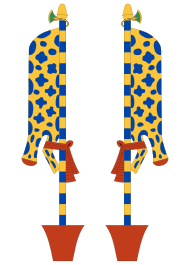
Imiut fetish
Encyclopedia

Ancient Egypt
Ancient Egypt was an ancient civilization of Northeastern Africa, concentrated along the lower reaches of the Nile River in what is now the modern country of Egypt. Egyptian civilization coalesced around 3150 BC with the political unification of Upper and Lower Egypt under the first pharaoh...
. This was a stuffed, headless animal skin, often a feline or bull, which was tied by the tail to a pole terminating in a lotus
Lotus (plant)
Lotus identifies various plant taxa:* Nelumbo, a genus of aquatic plants with showy flowers** Nelumbo nucifera, the Sacred or Indian lotus** Nelumbo lutea, the American or Yellow lotus...
bud, inserted into a stand. The fetish was present in Egyptian funerary
Funeral
A funeral is a ceremony for celebrating, sanctifying, or remembering the life of a person who has died. Funerary customs comprise the complex of beliefs and practices used by a culture to remember the dead, from interment itself, to various monuments, prayers, and rituals undertaken in their honor...
rites from the earliest ages. Although its origin and purpose is unknown, the imiut fetish dates as far back as to the First Dynasty
First dynasty of Egypt
The first dynasty of Ancient Egypt is often combined with the Dynasty II under the group title, Early Dynastic Period of Egypt...
(3100-2890 BC).
History
In very early Egyptian mythologyEgyptian mythology
Ancient Egyptian religion was a complex system of polytheistic beliefs and rituals which were an integral part of ancient Egyptian society. It centered on the Egyptians' interaction with a multitude of deities who were believed to be present in, and in control of, the forces and elements of nature...
, the deity Imiut (meaning, "He who is in his wrappings") may have been a god
Egyptian pantheon
The Egyptian pantheon consisted of the many gods worshipped by the Ancient Egyptians. A number of major deities are addressed as the creator of the cosmos. These include Atum, Ra, Amun and Ptah amongst others, as well as composite forms of these gods such as Amun-Ra. This was not seen as...
of the underworld
Underworld
The Underworld is a region which is thought to be under the surface of the earth in some religions and in mythologies. It could be a place where the souls of the recently departed go, and in some traditions it is identified with Hell or the realm of death...
, although insufficient records survive to explain whether this was the case. An early example found in 1914 by an expedition of the Metropolitan Museum of Art
Metropolitan Museum of Art
The Metropolitan Museum of Art is a renowned art museum in New York City. Its permanent collection contains more than two million works, divided into nineteen curatorial departments. The main building, located on the eastern edge of Central Park along Manhattan's Museum Mile, is one of the...
near the pyramid of Senusret I
Senusret I
Senusret I was the second pharaoh of the Twelfth Dynasty of Egypt. He ruled from 1971 BC to 1926 BC, and was one of the most powerful kings of this Dynasty. He was the son of Amenemhat I and his wife Nefertitanen. His wife and sister was Neferu. She was also the mother of the successor Amenemhat II...
(c. 1971-1928 BCE) was placed in a shrine.
Since it was later connected to the god Anubis
Anubis
Anubis is the Greek name for a jackal-headed god associated with mummification and the afterlife in ancient Egyptian religion. In the ancient Egyptian language, Anubis is known as Inpu . According to the Akkadian transcription in the Amarna letters, Anubis' name was vocalized as Anapa...
, it is sometimes called the Anubis fetish. One idea is that it came to symbolise Anubis as an embalmer, although this is unlikely to be the original understanding, as Anubis was originally a god of the dead, rather than just embalming. There are depictions of the imiut fetish on ancient Egyptian temples, and sometimes there were models of it included with the funerary equipment, most notably the two found in the burial chamber of Tutankhamun
Tutankhamun
Tutankhamun , Egyptian , ; approx. 1341 BC – 1323 BC) was an Egyptian pharaoh of the 18th dynasty , during the period of Egyptian history known as the New Kingdom...
by Howard Carter
Howard Carter (archaeologist)
Howard Carter was an English archaeologist and Egyptologist, noted as a primary discoverer of the tomb of Tutankhamun.-Beginning of career:...
.
External links
- Imiut fetish article from Ancient Egypt Online
- Anubis, God of Embalming and Guide and Friend of the Dead contains picture and description of fetish

